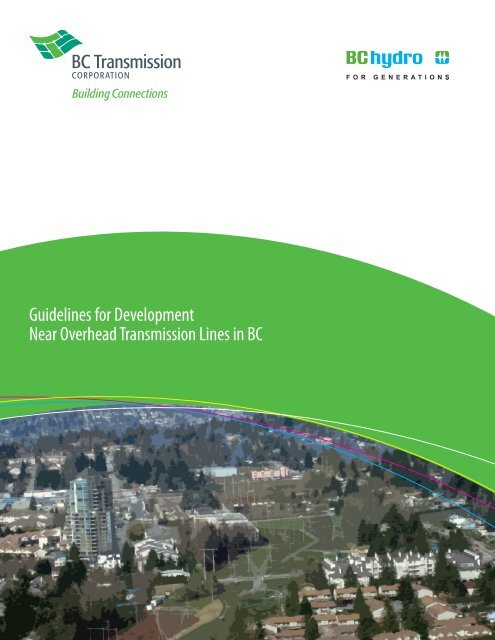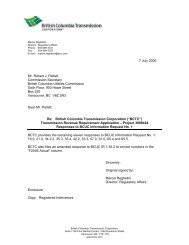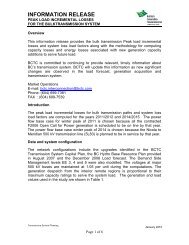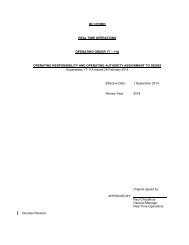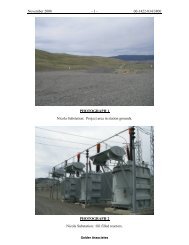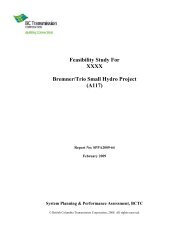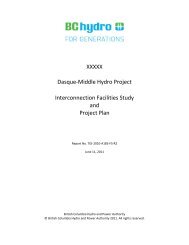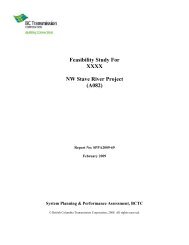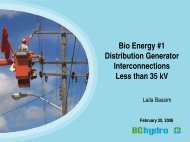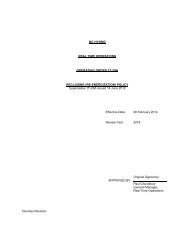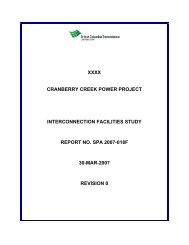Guidelines for Development Near Overhead Transmission Lines in BC
Guidelines for Development Near Overhead Transmission Lines in BC
Guidelines for Development Near Overhead Transmission Lines in BC
You also want an ePaper? Increase the reach of your titles
YUMPU automatically turns print PDFs into web optimized ePapers that Google loves.
<strong>Guidel<strong>in</strong>es</strong> <strong>for</strong> <strong>Development</strong><br />
<strong>Near</strong> <strong>Overhead</strong> <strong>Transmission</strong> <strong>L<strong>in</strong>es</strong> <strong>in</strong> <strong>BC</strong>
Project Overview<br />
<strong>BC</strong> <strong>Transmission</strong> Corporation and <strong>BC</strong> Hydro 3<br />
Characteristics of <strong>Transmission</strong> Towers 7<br />
Design<strong>in</strong>g Around Power <strong>L<strong>in</strong>es</strong> 9<br />
Power Safety and Rights-of-Way Uses 23<br />
Glossary 29<br />
Frequently Asked Questions 33<br />
Sources & Acknowledgements 35<br />
2<br />
<strong>Guidel<strong>in</strong>es</strong> <strong>for</strong> <strong>Development</strong><br />
<strong>Near</strong> <strong>Overhead</strong> <strong>Transmission</strong> <strong>L<strong>in</strong>es</strong> <strong>in</strong> <strong>BC</strong>
<strong>BC</strong> <strong>Transmission</strong> Corporation and <strong>BC</strong> Hydro<br />
<strong>BC</strong> <strong>Transmission</strong> Corporation (<strong>BC</strong>TC) and <strong>BC</strong> Hydro: “the Utilities”<br />
<strong>BC</strong> <strong>Transmission</strong> Corporation (<strong>BC</strong>TC) was established <strong>in</strong> 2003 as the prov<strong>in</strong>cial Crown corporation to focus on plann<strong>in</strong>g,<br />
build<strong>in</strong>g, operat<strong>in</strong>g and ma<strong>in</strong>ta<strong>in</strong><strong>in</strong>g a safe, reliable and cost-effective power grid. Electricity is delivered through an<br />
<strong>in</strong>terconnected system of more than 18,000 kilometres of transmission l<strong>in</strong>es. This <strong>in</strong>cludes the management of 20,500 steel<br />
towers, 100,000 wood poles and 287 substations.<br />
<strong>BC</strong>TC is responsible <strong>for</strong> operat<strong>in</strong>g, plann<strong>in</strong>g and ma<strong>in</strong>ta<strong>in</strong><strong>in</strong>g <strong>BC</strong> Hydro’s high-voltage electric transmission grid, and<br />
<strong>BC</strong> Hydro reta<strong>in</strong>s ownership of the physical assets and the legal tenure <strong>for</strong> the rights-of-way. As the system asset owner,<br />
<strong>BC</strong> Hydro acquires certa<strong>in</strong> rights from landowners (<strong>in</strong>clud<strong>in</strong>g private property owners, First Nations, municipalities and the<br />
prov<strong>in</strong>cial and federal Crown) to <strong>in</strong>stall, replace, ma<strong>in</strong>ta<strong>in</strong> and access works related to the electrical delivery system. For the<br />
transmission system, this is done <strong>in</strong> response to <strong>BC</strong>TC requirements. Because both utilities are <strong>in</strong>volved <strong>in</strong> the management<br />
of the right-of-way they are referred to jo<strong>in</strong>tly as “the Utilities”.<br />
Lands under transmission l<strong>in</strong>es and towers<br />
(generally referred to as transmission facilities)<br />
are usually owned by private landowners, while<br />
the Utilities ma<strong>in</strong>ta<strong>in</strong> specific rights govern<strong>in</strong>g<br />
their use. These lands are called rights-of-way<br />
(ROWs). The ROW agreements restrict owners’<br />
rights to activities that do not impact public<br />
safety, <strong>in</strong>terfere with the operation of the l<strong>in</strong>es,<br />
cause a safety hazard, or <strong>in</strong>terfere with the rights<br />
granted. These agreements also usually allow<br />
the Utilities to construct, ma<strong>in</strong>ta<strong>in</strong> and replace<br />
exist<strong>in</strong>g facilities, as well as reserve space <strong>for</strong><br />
future facilities.<br />
3<br />
<strong>Guidel<strong>in</strong>es</strong> <strong>for</strong> <strong>Development</strong><br />
<strong>Near</strong> <strong>Overhead</strong> <strong>Transmission</strong> <strong>L<strong>in</strong>es</strong> <strong>in</strong> <strong>BC</strong>
What is the purpose of this document?<br />
This document aims to promote the successful development of sites crossed by ROWs and the creation of welldesigned<br />
places. It demonstrates that a well-thought-out design approach can:<br />
• Successfully <strong>in</strong>corporate the Utilities’ ROWs with<strong>in</strong> developments<br />
• M<strong>in</strong>imize the impact of overhead l<strong>in</strong>es with<strong>in</strong> a quality liv<strong>in</strong>g environment<br />
• Integrate the growth of <strong>BC</strong>’s transmission system and communities <strong>in</strong> an effective way through partnership with<br />
landowners, communities and developers<br />
ROW conta<strong>in</strong><strong>in</strong>g two l<strong>in</strong>es of 500kV transmission towers<br />
4<br />
<strong>Guidel<strong>in</strong>es</strong> <strong>for</strong> <strong>Development</strong><br />
<strong>Near</strong> <strong>Overhead</strong> <strong>Transmission</strong> <strong>L<strong>in</strong>es</strong> <strong>in</strong> <strong>BC</strong>
<strong>BC</strong> <strong>Transmission</strong> Corporation and <strong>BC</strong> Hydro<br />
Who will use this document?<br />
These guidel<strong>in</strong>es are <strong>for</strong> the use of any <strong>in</strong>dividual <strong>in</strong>terested <strong>in</strong> land<br />
development near transmission facilities.<br />
Property Owners<br />
These guidel<strong>in</strong>es will assist property owners seek<strong>in</strong>g to maximize<br />
use of their land along the Utilities’ ROWs by provid<strong>in</strong>g a set of<br />
recommendations <strong>for</strong> appropriate land use and safety guidel<strong>in</strong>es.<br />
Local Government<br />
These guidel<strong>in</strong>es will promote awareness of the potential to<br />
develop and improve the environmental quality of land close<br />
to transmission ROWs, and pro vide supplementary plann<strong>in</strong>g<br />
guidance on the development of ROWs. They also provide a<br />
basis <strong>for</strong> analyz<strong>in</strong>g and approv<strong>in</strong>g land development located<br />
<strong>in</strong> close proximity to the Utilities’ facilities.<br />
<strong>Transmission</strong> l<strong>in</strong>es across the City of Vancouver<br />
Developers and Designers<br />
These guidel<strong>in</strong>es will help provide clarity about the design constra<strong>in</strong>ts posed by transmission ROWs, along with greater<br />
awareness of the opportunities to improve the environment and there<strong>for</strong>e the value of the development through good<br />
design.<br />
Communities<br />
This guide is a useful resource <strong>for</strong> communities plann<strong>in</strong>g <strong>for</strong> growth, because it provides guidel<strong>in</strong>es <strong>for</strong> the successful<br />
development of land close to high voltage overhead l<strong>in</strong>es and with<strong>in</strong> transmission ROWs.<br />
5<br />
<strong>Guidel<strong>in</strong>es</strong> <strong>for</strong> <strong>Development</strong><br />
<strong>Near</strong> <strong>Overhead</strong> <strong>Transmission</strong> <strong>L<strong>in</strong>es</strong> <strong>in</strong> <strong>BC</strong>
<strong>BC</strong>TC’s transmission system crosses over 75,000 hectares<br />
of land and consists of approximately 18,000 kilometres of<br />
transmission l<strong>in</strong>es, 20,500 steel towers, 100,000 wood poles<br />
and 287 substations.<br />
6<br />
<strong>Guidel<strong>in</strong>es</strong> <strong>for</strong> <strong>Development</strong><br />
<strong>Near</strong> <strong>Overhead</strong> <strong>Transmission</strong> <strong>L<strong>in</strong>es</strong> <strong>in</strong> <strong>BC</strong>
Characteristics of <strong>Transmission</strong> Towers<br />
Characteristics of <strong>Transmission</strong> Towers<br />
<strong>Transmission</strong> towers and l<strong>in</strong>es they support are the most visible aspect of the Utilities’ <strong>in</strong>frastructure on the landscape. <strong>BC</strong>TC<br />
manages a wide variety of towers and l<strong>in</strong>es that deliver electricity across the prov<strong>in</strong>ce. Three common types of towers are<br />
shown below.<br />
138 kV Wishbone Woodpole Structure<br />
230 kV Double Circuit<br />
Aesthetic Steel Pole Structure<br />
500 kV Steel Lattice Structure<br />
7<br />
<strong>Guidel<strong>in</strong>es</strong> <strong>for</strong> <strong>Development</strong><br />
<strong>Near</strong> <strong>Overhead</strong> <strong>Transmission</strong> <strong>L<strong>in</strong>es</strong> <strong>in</strong> <strong>BC</strong>
With effective plann<strong>in</strong>g and design,<br />
transmission corridors can benefit landowners<br />
and create better, more aesthetically pleas<strong>in</strong>g communities.<br />
8<br />
<strong>Guidel<strong>in</strong>es</strong> <strong>for</strong> <strong>Development</strong><br />
<strong>Near</strong> <strong>Overhead</strong> <strong>Transmission</strong> <strong>L<strong>in</strong>es</strong> <strong>in</strong> <strong>BC</strong>
Design<strong>in</strong>g Around Power <strong>L<strong>in</strong>es</strong><br />
Design<strong>in</strong>g Around Power <strong>L<strong>in</strong>es</strong><br />
Landowners and developers often see proximity to<br />
overhead transmission l<strong>in</strong>es and ROWs as a factor that may<br />
be detrimental to property values. However, with effective<br />
plann<strong>in</strong>g and design, transmission corridors can benefit<br />
landowners and create better, more aesthetically pleas<strong>in</strong>g<br />
communities.<br />
The guidel<strong>in</strong>es are meant to assist designers seek<strong>in</strong>g to develop<br />
an <strong>in</strong>tegrated design solution to sites crossed by ROWs. When<br />
plann<strong>in</strong>g and design<strong>in</strong>g residential, commercial or <strong>in</strong>dustrial<br />
activities around ROWs, there are many elements to consider.<br />
It is important to conduct a thorough survey of the site and the<br />
surround<strong>in</strong>g area with a detailed analysis of the transmission<br />
towers and poles with<strong>in</strong> view of the site be<strong>for</strong>e beg<strong>in</strong>n<strong>in</strong>g<br />
design. In addition, it is useful to know the rights and<br />
responsibilities of the property owner, as they may be different<br />
<strong>for</strong> each property.<br />
• A ROW on private property creates<br />
opportunities <strong>for</strong> <strong>in</strong>dividual property owners<br />
to enjoy larger lot sizes with the potential <strong>for</strong><br />
large gardens and outdoor spaces<br />
• The use of public ROW corridors <strong>for</strong> public<br />
amenities such as walk<strong>in</strong>g trails, play<strong>in</strong>g<br />
fields and bicycle paths contributes to<br />
attractive communities<br />
• This can <strong>in</strong>crease neighbourhood appeal and<br />
property values<br />
What about Underground <strong>Transmission</strong> <strong>L<strong>in</strong>es</strong>?<br />
Plac<strong>in</strong>g transmission l<strong>in</strong>es underground is an alternative to overhead l<strong>in</strong>es, and is considered on a case-by-case basis.<br />
However, underground<strong>in</strong>g is an expensive alternative, cost<strong>in</strong>g between 10 and 40 times more than overhead towers and<br />
l<strong>in</strong>es. The cost to underground exist<strong>in</strong>g l<strong>in</strong>es is the responsibility of the landowner or developer, not <strong>BC</strong>TC or <strong>BC</strong> Hydro.<br />
Us<strong>in</strong>g the ROW as a public walk<strong>in</strong>g path<br />
9<br />
<strong>Guidel<strong>in</strong>es</strong> <strong>for</strong> <strong>Development</strong><br />
<strong>Near</strong> <strong>Overhead</strong> <strong>Transmission</strong> <strong>L<strong>in</strong>es</strong> <strong>in</strong> <strong>BC</strong>
Topography<br />
The topography of a development site is an<br />
important design consideration as it can affect the<br />
visual perception of transmission facilities.<br />
Where towers are set <strong>in</strong> an elevated position and<br />
are viewed from lower ground, the scale and visual<br />
impact of the towers is emphasized. Conversely,<br />
where towers are viewed from an elevated position<br />
the visual impact is reduced.<br />
Towers set across the brow of a hill will be silhouetted<br />
aga<strong>in</strong>st the sky and will appear more prom<strong>in</strong>ent than<br />
towers set <strong>in</strong> a similarly elevated position but with<br />
ris<strong>in</strong>g land or development beh<strong>in</strong>d them. Even subtle<br />
level changes across a development site can be of<br />
great importance <strong>in</strong> this respect. If plann<strong>in</strong>g changes<br />
<strong>in</strong> elevation with<strong>in</strong> the ROW the Utilities must be<br />
contacted as any reduction <strong>in</strong> the clearance between<br />
the conductor and ground can create a potential<br />
safety risk.<br />
By tak<strong>in</strong>g topography <strong>in</strong>to account, the visual effect<br />
of power l<strong>in</strong>es can be mitigated.<br />
Towers are more prom<strong>in</strong>ent when placed aga<strong>in</strong>st the skyl<strong>in</strong>e, as <strong>in</strong> the diagram to the left.<br />
10<br />
<strong>Guidel<strong>in</strong>es</strong> <strong>for</strong> <strong>Development</strong><br />
<strong>Near</strong> <strong>Overhead</strong> <strong>Transmission</strong> <strong>L<strong>in</strong>es</strong> <strong>in</strong> <strong>BC</strong>
Design<strong>in</strong>g Around Power <strong>L<strong>in</strong>es</strong><br />
Density<br />
The density of development can play a key role <strong>in</strong> screen<strong>in</strong>g views of the transmission facilities. By plac<strong>in</strong>g non-residential<br />
build<strong>in</strong>gs nearest to the transmission facilities, views of the l<strong>in</strong>e are screened from most public and residential areas.<br />
Higher density residential build<strong>in</strong>gs close to transmission facilities may create a negative perception to the residents. The<br />
l<strong>in</strong>es may appear closer from the upper floors of a multi-storey build<strong>in</strong>g.<br />
It is important to create a harmony between density, align ment, orientation and landscap<strong>in</strong>g <strong>in</strong><br />
order to create an aesthetically appeal<strong>in</strong>g development.<br />
Alignment & Orientation<br />
When develop<strong>in</strong>g new subdivisions and communities, vary<strong>in</strong>g the alignment of streets and paths can reduce the<br />
number of views of transmission towers, m<strong>in</strong>imiz<strong>in</strong>g their impact and reduc<strong>in</strong>g the impression of a l<strong>in</strong>ear corridor.<br />
Build<strong>in</strong>gs should be oriented to m<strong>in</strong>imize direct views of towers from residences. This can result <strong>in</strong> some developments<br />
fac<strong>in</strong>g the overhead power l<strong>in</strong>es, rather than the towers. The use of a ‘rectangular’ build<strong>in</strong>g block <strong>for</strong>m, oriented<br />
perpendicular or at an angle to the l<strong>in</strong>es, offers the opportunity to m<strong>in</strong>imize direct views towards the transmission facilities,<br />
thereby reduc<strong>in</strong>g the visual impact from streets, build<strong>in</strong>gs and gardens. This orientation is best suited <strong>for</strong> high- and<br />
medium-density developments, usually <strong>in</strong> the <strong>for</strong>m of apartments and townhomes.<br />
Orient<strong>in</strong>g build<strong>in</strong>g blocks parallel to the transmission route could <strong>in</strong>crease the numbers of homes with views of the l<strong>in</strong>e<br />
and <strong>for</strong> higher voltage l<strong>in</strong>es may cause problems with <strong>in</strong>duced currents.<br />
11<br />
<strong>Guidel<strong>in</strong>es</strong> <strong>for</strong> <strong>Development</strong><br />
<strong>Near</strong> <strong>Overhead</strong> <strong>Transmission</strong> <strong>L<strong>in</strong>es</strong> <strong>in</strong> <strong>BC</strong>
Alignment & Orientation<br />
Build<strong>in</strong>gs that are not square <strong>in</strong> <strong>for</strong>m provide the opportunity<br />
to be oriented <strong>in</strong> many ways, avoid<strong>in</strong>g direct views along the<br />
transmission route.<br />
Orient<strong>in</strong>g build<strong>in</strong>g blocks parallel to the transmission route<br />
could <strong>in</strong>crease the numbers of homes with views of the l<strong>in</strong>e.<br />
Align<strong>in</strong>g homes between towers, as opposed to aga<strong>in</strong>st towers along transmission corridors<br />
helps to reduce the visual impact of tower l<strong>in</strong>es.<br />
12<br />
<strong>Guidel<strong>in</strong>es</strong> <strong>for</strong> <strong>Development</strong><br />
<strong>Near</strong> <strong>Overhead</strong> <strong>Transmission</strong> <strong>L<strong>in</strong>es</strong> <strong>in</strong> <strong>BC</strong>
Design<strong>in</strong>g Around Power <strong>L<strong>in</strong>es</strong><br />
Alignment & Orientation<br />
<strong>Development</strong>s adjacent to ROWs can also be left open ended, with the resultant space<br />
used to create public gardens, squares or park<strong>in</strong>g lots.<br />
The orientation of homes parallel to the ROW does<br />
little to m<strong>in</strong>imize the visual impact of the l<strong>in</strong>es from<br />
<strong>in</strong>side the homes, as <strong>in</strong> the first diagram.<br />
Locat<strong>in</strong>g cul-de-sacs on the edges of the right-of- way<br />
and between towers m<strong>in</strong>imizes the visual<br />
impact of the towers and l<strong>in</strong>es from each s<strong>in</strong>gle family<br />
dwell<strong>in</strong>g, as <strong>in</strong> the second diagram.<br />
Residential<br />
Lots<br />
ROW<br />
13<br />
<strong>Guidel<strong>in</strong>es</strong> <strong>for</strong> <strong>Development</strong><br />
<strong>Near</strong> <strong>Overhead</strong> <strong>Transmission</strong> <strong>L<strong>in</strong>es</strong> <strong>in</strong> <strong>BC</strong>
Non-l<strong>in</strong>ear alignment of streets and roads provides opportunities to<br />
m<strong>in</strong>imize the view of power l<strong>in</strong>es from build<strong>in</strong>gs.<br />
Vary<strong>in</strong>g the lot angles and placement of build<strong>in</strong>gs can greatly reduce the visual impacts of transmission l<strong>in</strong>es.<br />
14<br />
<strong>Guidel<strong>in</strong>es</strong> <strong>for</strong> <strong>Development</strong><br />
<strong>Near</strong> <strong>Overhead</strong> <strong>Transmission</strong> <strong>L<strong>in</strong>es</strong> <strong>in</strong> <strong>BC</strong>
Design<strong>in</strong>g Around Power <strong>L<strong>in</strong>es</strong><br />
Alignment & Orientation<br />
By curv<strong>in</strong>g streets and paths, even with relatively small curves, you can significantly reduce the visual impact of towers.<br />
Views fac<strong>in</strong>g towards transmission l<strong>in</strong>es can be oriented some distance from the towers, and can also be framed by new<br />
street scenes and public open spaces, particularly where changes <strong>in</strong> topography occur.<br />
The arrangement of build<strong>in</strong>gs, boundaries, fences, paths and landscap<strong>in</strong>g <strong>in</strong> parallel with the transmission route over long<br />
distances will tend to highlight the presence of overhead power l<strong>in</strong>es and the l<strong>in</strong>ear nature of the route and will make them<br />
more obtrusive.(Parallel structures to the ROW can also create <strong>in</strong>duced currents). However, where one or more of these<br />
elements is varied and is not parallel, the l<strong>in</strong>earity of the transmission route and its overall prom<strong>in</strong>ence can be reduced.<br />
Curved paths should also be angled to avoid end<strong>in</strong>g visually at a tower, as below. This helps to reduce the visual impact of<br />
transmission towers.<br />
Left A street with an end po<strong>in</strong>t towards<br />
a transmission tower gives prom<strong>in</strong>ence<br />
to the tower.<br />
Right By alter<strong>in</strong>g the street pattern, the<br />
visual effect of the tower is m<strong>in</strong>imized.<br />
15<br />
<strong>Guidel<strong>in</strong>es</strong> <strong>for</strong> <strong>Development</strong><br />
<strong>Near</strong> <strong>Overhead</strong> <strong>Transmission</strong> <strong>L<strong>in</strong>es</strong> <strong>in</strong> <strong>BC</strong>
Distance<br />
Vary<strong>in</strong>g the distance of development from transmission facilities is an important design tool. Build<strong>in</strong>gs are not permitted<br />
with<strong>in</strong> the ROW. Adjacent build<strong>in</strong>gs should be kept, as a m<strong>in</strong>imum, at the edge of the ROW, and set back to allow uses not<br />
otherwise permitted to take place with<strong>in</strong> the ROW (e.g. <strong>in</strong>ground swimm<strong>in</strong>g pools, greenhouses, garages, etc)<br />
Plac<strong>in</strong>g the pr<strong>in</strong>cipal build<strong>in</strong>g of a development centrally with<strong>in</strong> a lot, or even set back from the ROW, creates multiple<br />
opportunities <strong>for</strong> the landowner with fewer restrictions. In a residential development, this creates space <strong>for</strong> both front and<br />
rear yards. In commercial sett<strong>in</strong>gs, the area of the lot with<strong>in</strong> the ROW may be used <strong>for</strong> park<strong>in</strong>g and other amenities.<br />
Sett<strong>in</strong>g back residential lots from the ROW reduces the visual impact.<br />
16<br />
<strong>Guidel<strong>in</strong>es</strong> <strong>for</strong> <strong>Development</strong><br />
<strong>Near</strong> <strong>Overhead</strong> <strong>Transmission</strong> <strong>L<strong>in</strong>es</strong> <strong>in</strong> <strong>BC</strong>
Design<strong>in</strong>g Around Power <strong>L<strong>in</strong>es</strong><br />
Landscap<strong>in</strong>g & Screen<strong>in</strong>g<br />
Landscap<strong>in</strong>g is one of the most effective methods to diffuse<br />
the effects of transmission facilities, while trans<strong>for</strong>m<strong>in</strong>g the<br />
space with<strong>in</strong> and adjacent to the ROW <strong>in</strong>to an aesthetically<br />
pleas<strong>in</strong>g amenity to homeowners. Screen<strong>in</strong>g can enhance the<br />
quality and <strong>in</strong>timacy of the immediate sett<strong>in</strong>g by creat<strong>in</strong>g the<br />
perception that towers have receded <strong>in</strong>to the distance.<br />
Consideration should there<strong>for</strong>e be given to the use of<br />
screen<strong>in</strong>g <strong>in</strong> layers with vary<strong>in</strong>g heights to match site<br />
circumstances. Mature trees planted along streets can<br />
effectively screen views and enhance the residential<br />
environment. Layers of plant<strong>in</strong>g create a series of silhouettes<br />
<strong>in</strong>to the distance, creat<strong>in</strong>g depth <strong>in</strong> the field of vision that<br />
helps to reduce the visual impact of the transmission facilities.<br />
In this way, views of towers can be effectively screened<br />
without the need <strong>for</strong> cont<strong>in</strong>uous belts of plant<strong>in</strong>g. Views of<br />
towers can be obscured <strong>for</strong> much of the year <strong>in</strong> areas where<br />
the branches of mature trees arch over the street.<br />
Appropriate low grow<strong>in</strong>g vegetation can be located with<strong>in</strong><br />
the ROW, while larger species can be planted near the edge<br />
of the ROW. At the edge of the ROW, the species must be<br />
planted far enough from the transmission facilities as not to<br />
pose a threat to the facilities (sway<strong>in</strong>g <strong>in</strong>to the wires, etc).<br />
Street plant<strong>in</strong>g can be ‘retro-fitted’ to exist<strong>in</strong>g<br />
environments to soften the visual impact of towers<br />
and overhead power l<strong>in</strong>es.<br />
With<strong>in</strong> the ROW, trees and shrubs generally cannot exceed<br />
3 metres <strong>in</strong> height at maturity. The use of the ROW <strong>for</strong><br />
plant<strong>in</strong>g and garden<strong>in</strong>g provides a valuable amenity to<br />
<strong>in</strong>dividual landowners or communities, who may use the<br />
ROW as a shared garden. The Utilities would need to be<br />
consulted <strong>for</strong> such uses of the ROW.<br />
17<br />
<strong>Guidel<strong>in</strong>es</strong> <strong>for</strong> <strong>Development</strong><br />
<strong>Near</strong> <strong>Overhead</strong> <strong>Transmission</strong> <strong>L<strong>in</strong>es</strong> <strong>in</strong> <strong>BC</strong>
Left In this image, the visual impact of power l<strong>in</strong>es<br />
is very strong, as little attention has been paid to<br />
varied orientation or the use of landscap<strong>in</strong>g to ‘hide’<br />
the towers.<br />
Right This image illustrates how screen<strong>in</strong>g and<br />
landscap<strong>in</strong>g can dim<strong>in</strong>ish the visual impact of power l<strong>in</strong>es<br />
<strong>in</strong> residential neighbourhoods.<br />
A comb<strong>in</strong>ation of curved streets,<br />
rectangular build<strong>in</strong>g patterns,<br />
landscap<strong>in</strong>g and screen<strong>in</strong>g can<br />
be seen <strong>in</strong> the example to the<br />
left, while the ROW underneath<br />
the l<strong>in</strong>es has been developed <strong>in</strong>to<br />
community amenities.<br />
18<br />
<strong>Guidel<strong>in</strong>es</strong> <strong>for</strong> <strong>Development</strong><br />
<strong>Near</strong> <strong>Overhead</strong> <strong>Transmission</strong> <strong>L<strong>in</strong>es</strong> <strong>in</strong> <strong>BC</strong>
Design<strong>in</strong>g Around Power <strong>L<strong>in</strong>es</strong><br />
Community Amenities With<strong>in</strong> the ROW<br />
While use of the ROW has some restrictions (as per the statutory right-of-way agreements) the presence of long corridors<br />
of clear, open space provides the opportunity to develop significant private and community amenities. In order to best use<br />
this space, it is important to consider design ideas such as:<br />
• Break<strong>in</strong>g the transmission route <strong>in</strong>to cells us<strong>in</strong>g roads, bridges, etc.<br />
• Develop<strong>in</strong>g such cells <strong>for</strong> uses such as garden squares and park<strong>in</strong>g lots<br />
• Creat<strong>in</strong>g meander<strong>in</strong>g paths and varied plant<strong>in</strong>g<br />
• Provid<strong>in</strong>g a mix of activities beneath and adjacent to the overhead power l<strong>in</strong>e<br />
Some examples of compatible uses with<strong>in</strong> the ROW are<br />
outl<strong>in</strong>ed <strong>in</strong> the next section. The process that the Utilities<br />
use to review compatible ROW uses is outl<strong>in</strong>ed <strong>in</strong> a separate<br />
document called Partners <strong>in</strong> Use, Rights-of-Way <strong>Guidel<strong>in</strong>es</strong> <strong>for</strong><br />
Compatible Uses. Developers should keep <strong>in</strong> m<strong>in</strong>d that such<br />
uses are site specific and would require prior approval from the<br />
Utilities, on a case-by-case basis.<br />
19<br />
<strong>Guidel<strong>in</strong>es</strong> <strong>for</strong> <strong>Development</strong><br />
<strong>Near</strong> <strong>Overhead</strong> <strong>Transmission</strong> <strong>L<strong>in</strong>es</strong> <strong>in</strong> <strong>BC</strong>
Play<strong>in</strong>g Fields & Golf Courses<br />
Recreational play<strong>in</strong>g fields may be located with<strong>in</strong> the ROW, subject to the nature of the activity, the layout of play<strong>in</strong>g fields<br />
and the level of supervision. The location and type of light<strong>in</strong>g used <strong>for</strong> play<strong>in</strong>g fields with<strong>in</strong> the ROW needs to be reviewed<br />
by the Utilities.<br />
Play<strong>in</strong>g fields located with<strong>in</strong> the ROW.<br />
Left Golf course with<strong>in</strong> the ROW with l<strong>in</strong>es<br />
buried underground.<br />
Right Golf course with overhead l<strong>in</strong>es with<strong>in</strong> the ROW.<br />
20<br />
<strong>Guidel<strong>in</strong>es</strong> <strong>for</strong> <strong>Development</strong><br />
<strong>Near</strong> <strong>Overhead</strong> <strong>Transmission</strong> <strong>L<strong>in</strong>es</strong> <strong>in</strong> <strong>BC</strong>
Design<strong>in</strong>g Around Power <strong>L<strong>in</strong>es</strong><br />
Nature and Conservation<br />
The retention or creation of nature conservation areas may be particularly suitable where public access to the area is<br />
restricted or prevented. The trails shown follow McLellan Creek and connect to HiKnoll Park nature conservation area <strong>in</strong><br />
Sur rey and Brydon Lagoon <strong>in</strong> the City of Langley. These areas <strong>for</strong>m a part of the Cloverdale and Serpent<strong>in</strong>e Greenway.<br />
Circulation Paths<br />
Active recreation paths, roads, cycle paths and walkways may be<br />
successfully accommodated beneath high voltage overhead l<strong>in</strong>es.<br />
Design ef<strong>for</strong>ts should seek to orient the path or trail alignment at least<br />
six metres away from the Utilities’ facilities.<br />
Christmas Tree Farms, Allotments<br />
and Community Orchards<br />
The use of land <strong>for</strong> allotments and community orchards may be<br />
appropriate subject to ma<strong>in</strong>ta<strong>in</strong><strong>in</strong>g safety, security and operational<br />
clearances which are determ<strong>in</strong>ed by the Utilities on a site-specific<br />
basis, depend<strong>in</strong>g on transmission l<strong>in</strong>e voltage and tree species.<br />
Serpent<strong>in</strong>e Greenway, Surrey, <strong>BC</strong><br />
Park<strong>in</strong>g<br />
Secondary park<strong>in</strong>g may be accommodated beneath high voltage<br />
overhead l<strong>in</strong>es subject to safety, security and operational concerns be<strong>in</strong>g<br />
met. The Utilities need to review any proposed park<strong>in</strong>g area on a sitespecific<br />
basis to ensure safety clearances from vehicles to conductors.<br />
Private Gardens<br />
ROWs on <strong>BC</strong> Hydro and Crown land adjacent to private land may be<br />
licenced to extend private yards, enabl<strong>in</strong>g landowners to develop<br />
gardens and plant<strong>in</strong>g patches.<br />
Fish habitat, HiKnoll Park, Surrey, <strong>BC</strong><br />
21<br />
<strong>Guidel<strong>in</strong>es</strong> <strong>for</strong> <strong>Development</strong><br />
<strong>Near</strong> <strong>Overhead</strong> <strong>Transmission</strong> <strong>L<strong>in</strong>es</strong> <strong>in</strong> <strong>BC</strong>
CASE STUDY: Plateau Estates, Abbots<strong>for</strong>d<br />
Plateau Estates <strong>in</strong> Abbots<strong>for</strong>d was developed<br />
through a bare land strata agreement. Located alongside<br />
a ROW corridor, the development has created a desirable<br />
residential sett<strong>in</strong>g, where the effective placement of houses<br />
and landscap<strong>in</strong>g have mitigated impacts of transmission l<strong>in</strong>es<br />
and structures. The lands with<strong>in</strong> the ROW have been developed<br />
to create a community asset through effective landscap<strong>in</strong>g and<br />
land uses which are compatible with the transmis sion system<br />
and beneficial to the residents.<br />
Careful consideration was given to topography, with homes<br />
be<strong>in</strong>g developed at the highest po<strong>in</strong>ts of the site, wherever<br />
possible. This serves to reduce the prom<strong>in</strong>ence of the<br />
transmission facilities and creates an aesthetically pleas<strong>in</strong>g<br />
green space which falls away from the residences to wards the<br />
transmission l<strong>in</strong>es.<br />
The ROW, rather than be<strong>in</strong>g divided amongst <strong>in</strong> dividual homeowners, has been developed as an amenity <strong>for</strong><br />
residents of the community. As such, it provides space <strong>for</strong> open activities, picnics, sports and walk<strong>in</strong>g trails. There is<br />
also a tennis court at the edge of the ROW.<br />
22<br />
<strong>Guidel<strong>in</strong>es</strong> <strong>for</strong> <strong>Development</strong><br />
<strong>Near</strong> <strong>Overhead</strong> <strong>Transmission</strong> <strong>L<strong>in</strong>es</strong> <strong>in</strong> <strong>BC</strong>
Public Safety and Rights-of-Way Uses<br />
Public Safety and Rights-of-Way Uses<br />
When develop<strong>in</strong>g and design<strong>in</strong>g land located close to transmission l<strong>in</strong>es and<br />
with<strong>in</strong> ROWs, there are a number of factors related to public safety, facility<br />
security, ma<strong>in</strong>tenance and design to consider.<br />
Public Safety<br />
Contact, or near contact, with high voltage equipment is extremely<br />
dangerous and must be avoided. Objects that approach overhead electricity<br />
conductors too closely can cause fatal or severe shocks and burns. In order<br />
to prevent such <strong>in</strong>cidents, m<strong>in</strong>imum safety clearances <strong>for</strong> all overhead<br />
power l<strong>in</strong>es are prescribed, which must be ma<strong>in</strong>ta<strong>in</strong>ed between conductors<br />
and the ground, trees, build<strong>in</strong>gs, equipment and any other structures, such<br />
as street light<strong>in</strong>g.<br />
Public safety plays an<br />
important role when<br />
design<strong>in</strong>g around<br />
transmission <strong>in</strong>frastructure.<br />
It affects not only the general<br />
public, but the Utilities<br />
ma<strong>in</strong>tenance staff as well.<br />
The clearance required will depend on the operat<strong>in</strong>g voltage of the l<strong>in</strong>e, its<br />
construction and design, the topography of the location over which the l<strong>in</strong>e<br />
passes and the type of development proposed. The Utilities’ pre-approval is<br />
required when unload<strong>in</strong>g, stack<strong>in</strong>g or mov<strong>in</strong>g material underneath conductors<br />
and care should be taken <strong>in</strong> the construction of build<strong>in</strong>gs or other structures <strong>in</strong><br />
the vic<strong>in</strong>ity of an overhead power l<strong>in</strong>e.<br />
Generally, build<strong>in</strong>gs located outside of the ROW are safe from any<br />
of these concerns. However, build<strong>in</strong>gs located at or near the edge<br />
of the ROW may face certa<strong>in</strong> impacts from electric field <strong>in</strong>duction.<br />
These impacts can be mitigated if they are better understood at the<br />
time of the land development plann<strong>in</strong>g stage.<br />
Noth<strong>in</strong>g should ever be attached to a transmission tower or pole,<br />
whether temporary or permanent. Storage or use of hazardous<br />
materials is not permitted <strong>in</strong> or near ROWs. This <strong>in</strong>cludes anyth<strong>in</strong>g<br />
flammable, explosive, or corrosive.<br />
Developers and municipalities need to consider emergency access<br />
<strong>in</strong> the design of their developments where they plan to be adjacent to the right-of-way.<br />
Sufficient access and maneuver<strong>in</strong>g room <strong>for</strong> emergency equipment and trucks off the ROW, particularly <strong>for</strong> firefight<strong>in</strong>g<br />
must be ma<strong>in</strong>ta<strong>in</strong>ed. If a development adjacent to a ROW catches fire, firefighters need room to park vehicles, maneuver<br />
ladders, and shoot water from proper angles without putt<strong>in</strong>g themselves at risk from the transmission system.<br />
23<br />
<strong>Guidel<strong>in</strong>es</strong> <strong>for</strong> <strong>Development</strong><br />
<strong>Near</strong> <strong>Overhead</strong> <strong>Transmission</strong> <strong>L<strong>in</strong>es</strong> <strong>in</strong> <strong>BC</strong>
<strong>Guidel<strong>in</strong>es</strong> <strong>for</strong> Compatible Uses<br />
The Utilities have classified potential ROW uses as described below, to assist landowners and developers <strong>in</strong> design<strong>in</strong>g <strong>for</strong><br />
ROWs. See the Compatible Use <strong>Guidel<strong>in</strong>es</strong> <strong>for</strong> further details:<br />
http://www.bctc.com/the_transmission_system/rights_of_way_prop_rights/<br />
No significant impact<br />
The follow<strong>in</strong>g uses are considered to have “no<br />
significant impact” and do not require specific<br />
permission from the Utilities:<br />
• General landscap<strong>in</strong>g and residential gardens,<br />
provided there is no change <strong>in</strong> grade and<br />
vegetation has a maximum height of 3 metres<br />
at maturity<br />
• Graz<strong>in</strong>g of animals and agricultural uses (without<br />
mechanical irrigation systems or metallic fences)<br />
M<strong>in</strong>or impact<br />
The follow<strong>in</strong>g uses are considered to have “m<strong>in</strong>or<br />
impact” and should be reviewed by the Utilities prior<br />
to development:<br />
• Tree farms and other multi-year crops<br />
• Hik<strong>in</strong>g and equestrian trails, paths and walkways<br />
• Small garden sheds and storage of nonhazardous<br />
materials<br />
• Non-metallic water and sewer l<strong>in</strong>es, septic fields<br />
Major impact<br />
The follow<strong>in</strong>g uses are considered to be “major impact” and must be coord<strong>in</strong>ated by the utilities:<br />
• Driveways, access roads, utility cross<strong>in</strong>gs<br />
• Park<strong>in</strong>g, playgrounds, tennis courts, golf courses, cemeteries, swimm<strong>in</strong>g pools<br />
• Gravel pits, quarries, fill, berms, and reta<strong>in</strong><strong>in</strong>g walls<br />
• Any activity <strong>in</strong>volv<strong>in</strong>g elevation or grade changes more than 0.5 metres<br />
• Sewage disposal fields, detention/retention ponds, watercourse relocation<br />
• Portions of non-habitable build<strong>in</strong>gs (e.g. garages, carports)<br />
• Highways, roads and major pipel<strong>in</strong>es parallel to and/or with<strong>in</strong> the ROW<br />
• Street lamps and other light<strong>in</strong>g standards<br />
• Any activity <strong>in</strong>volv<strong>in</strong>g any type of mechanized equipment (e.g. excavators, bulldozers, irrigation systems)<br />
Refuel<strong>in</strong>g with<strong>in</strong> the ROW is not recommended, and <strong>in</strong> many ROW agreements it is specifically prohibited. In the <strong>in</strong>terest of<br />
safety, users should contact the Utilities be<strong>for</strong>e proceed<strong>in</strong>g with these k<strong>in</strong>ds of activities.<br />
24<br />
<strong>Guidel<strong>in</strong>es</strong> <strong>for</strong> <strong>Development</strong><br />
<strong>Near</strong> <strong>Overhead</strong> <strong>Transmission</strong> <strong>L<strong>in</strong>es</strong> <strong>in</strong> <strong>BC</strong>
Public Safety and Rights-of-Way Uses<br />
Ma<strong>in</strong>tenance Needs<br />
When transmission l<strong>in</strong>es are built, the poles or towers are placed on sites which<br />
have clear routes to allow ma<strong>in</strong>tenance crews to ga<strong>in</strong> access to them. Chang<strong>in</strong>g<br />
land use and the expansion of subdivisions cannot be allowed to impede access<br />
to poles or towers.<br />
When plann<strong>in</strong>g uses with<strong>in</strong> the ROW, it is important to consider ma<strong>in</strong>tenance<br />
requirements. <strong>Transmission</strong> l<strong>in</strong>es and towers require a m<strong>in</strong>imum of six metres of<br />
clearance on all sides to ensure safe access <strong>for</strong> ma<strong>in</strong>tenance workers.<br />
1. Induced Currents<br />
Landowners and developers should be aware of the potential <strong>for</strong> nuisance and startle shocks (caused by <strong>in</strong>duced voltage)<br />
that can occur when someone comes <strong>in</strong> contact with a large conductive object (eg. a vehicle, build<strong>in</strong>g or even fenc<strong>in</strong>g)<br />
located on or off the right-of-way. These shocks are known as ‘nuisance’ or ‘startle’ s<strong>in</strong>ce they will not physically hurt<br />
someone, but will be noticed by some people and provoke a startle reaction.<br />
These touch currents occur when a grounded <strong>in</strong>dividual touches an ungrounded object while stand<strong>in</strong>g <strong>in</strong> an Electric Field<br />
(e-field). Conductive objects when placed <strong>in</strong> an e-field attract a charge, and a person touch<strong>in</strong>g that object can experience<br />
an annoy<strong>in</strong>g or startl<strong>in</strong>g shock when a person’s body provides a path to ground <strong>for</strong> the current to follow.<br />
There are many factors which <strong>in</strong>fluence the likelihood of nuisance shocks and the extent that people will notice them.<br />
These <strong>in</strong>clude:<br />
• L<strong>in</strong>e voltage<br />
• Conductor to ground clearance<br />
• Size of the vehicle or object<br />
• Location on or off the right of way<br />
• Atmospheric conditions<br />
• Personal physiology<br />
Electric fields emanate from any conductor or wire that carries voltage. Higher l<strong>in</strong>e voltages produce higher electric<br />
field strengths. The closer the conductor is to the ground, the higher the field strength beneath it tends to be, and the<br />
<strong>in</strong>creased possibility of shocks.<br />
Larger objects such as a build<strong>in</strong>g or a large vehicle have the capability of a larger charge and there<strong>for</strong>e the shock could be<br />
more noticeable. Backyard metallic objects such as sw<strong>in</strong>gs, portable grills and lawnmowers have been known to deliver<br />
similar shocks. Ungrounded metal wire fences can also receive sufficient charges to cause nuisance shocks.<br />
25<br />
<strong>Guidel<strong>in</strong>es</strong> <strong>for</strong> <strong>Development</strong><br />
<strong>Near</strong> <strong>Overhead</strong> <strong>Transmission</strong> <strong>L<strong>in</strong>es</strong> <strong>in</strong> <strong>BC</strong>
Dur<strong>in</strong>g build<strong>in</strong>g construction, workers have also received shocks when <strong>in</strong>stall<strong>in</strong>g ungrounded gutters and downspouts on<br />
structures built close to the edge of the right-of-way. Homeowners may also experience shocks when clean<strong>in</strong>g gutters if<br />
the gutters are not properly grounded. Call the <strong>BC</strong> Hydro prov<strong>in</strong>cial rights-of-way help desk (1-800-667-1517) if you need<br />
advice or want assistance <strong>in</strong> properly ground<strong>in</strong>g metal objects.<br />
New Construction<br />
To date, no build<strong>in</strong>gs exceed<strong>in</strong>g two storeys <strong>in</strong> height have been placed immediately at the edge of a 500kV transmission<br />
right-of-way <strong>in</strong> British Columbia. Such build<strong>in</strong>gs may be subject to electric fields because of their height, length, orientation<br />
and their proximity to the transmission l<strong>in</strong>es. Accord<strong>in</strong>gly, owners or developers should reta<strong>in</strong> a professional consultant<br />
with expertise <strong>in</strong> calculat<strong>in</strong>g electric and magnetic fields, mitigation strategies, and safety issues dur<strong>in</strong>g construction and<br />
after occupancy. Consultants can advise on the project design and anticipated construction methods.<br />
It’s important to remember that even startle shocks could pose safety issues to construction workers or residents,<br />
depend<strong>in</strong>g on the activities <strong>in</strong> which they are engaged.<br />
Left A low rise residential structure<br />
located at the boundary of the ROW<br />
meets the requirements.<br />
Right A medium rise residential<br />
structure located on the boundary of<br />
the ROW meets the requirements, but<br />
can create <strong>in</strong>duced currents, as the<br />
upper levels of the build<strong>in</strong>g are close<br />
to the Utilities’ facilities.<br />
26<br />
<strong>Guidel<strong>in</strong>es</strong> <strong>for</strong> <strong>Development</strong><br />
<strong>Near</strong> <strong>Overhead</strong> <strong>Transmission</strong> <strong>L<strong>in</strong>es</strong> <strong>in</strong> <strong>BC</strong>
Public Safety and Rights-of-Way Uses<br />
Based on past experience, we have found it is important to:<br />
1. Ma<strong>in</strong>ta<strong>in</strong> the perpendicular orientation of the build<strong>in</strong>gs with respect to the 500 kV conductors.<br />
2. Br<strong>in</strong>g the electric service to the build<strong>in</strong>gs <strong>in</strong> from a dedicated distribution trans<strong>for</strong>mer with <strong>in</strong>dividual feeds kept<br />
perpendicular to the 500 kV conductors (metallic underground services should also be oriented perpendicularly).<br />
3. In all construction projects near 500 kV transmission l<strong>in</strong>es, engage a consultant knowledgeable <strong>in</strong> the calculation<br />
and management of electric fields.<br />
Top A tall build<strong>in</strong>g located at the boundary of the<br />
ROW meets the requirements, however it poses a high<br />
risk of <strong>in</strong>duction as the upper levels of the build<strong>in</strong>g are<br />
closer to the Utilities’ facilities.<br />
Bottom An alternative approach to high rise<br />
development that allows <strong>for</strong> <strong>in</strong>creased density but<br />
mitigates <strong>in</strong>duced currents.<br />
Fences and Metal Clothes <strong>L<strong>in</strong>es</strong><br />
In general, fences can be constructed near transmission l<strong>in</strong>es. However, the follow<strong>in</strong>g safety precautions should be observed.<br />
• Metal fences should not be attached to any tower or conductive pole<br />
• Metal fences should not be constructed with<strong>in</strong> five metres of any tower or conductive pole of a transmission l<strong>in</strong>e<br />
• Metallic objects such as metal clothes l<strong>in</strong>es should not be connected to poles or towers. If lightn<strong>in</strong>g or an<br />
electrical flash hits a pole or tower, momentary high currents and voltages could create a risk of electrocution<br />
• Metal fences runn<strong>in</strong>g parallel to the transmission facilities may need to be grounded at <strong>in</strong>tervals to reduce<br />
nuisance shocks<br />
27<br />
<strong>Guidel<strong>in</strong>es</strong> <strong>for</strong> <strong>Development</strong><br />
<strong>Near</strong> <strong>Overhead</strong> <strong>Transmission</strong> <strong>L<strong>in</strong>es</strong> <strong>in</strong> <strong>BC</strong>
2. Electric and Magnetic Fields (EMF)<br />
Power frequency (also referred to as extremely low frequency<br />
or ELF) electric and magnetic fields are present everywhere<br />
that electricity flows. All electric wires, and the electrical devices<br />
they supply, such as light bulbs, households appliances, and<br />
computers, are sources of electric and magnetic fields. Scientists<br />
have been research<strong>in</strong>g EMF and possible health effects <strong>for</strong> more<br />
than 30 years and this extensive research has not established a<br />
l<strong>in</strong>k between health risks and EMF. Lead<strong>in</strong>g health authorities<br />
say there is no reason to be concerned about exposure levels<br />
<strong>in</strong> typical Canadian homes and workplaces, regardless of the<br />
proximity to power l<strong>in</strong>es.<br />
Where can I f<strong>in</strong>d more<br />
<strong>in</strong><strong>for</strong>mation on EMF?<br />
Refer to the <strong>BC</strong>TC <strong>in</strong><strong>for</strong>mation sheet on<br />
EMF or search EMF at:<br />
http://www. bctc.com<br />
We realize that, regardless of the view of health authorities,<br />
some <strong>in</strong>dividuals have a different view. If people have any<br />
concerns we encourage them to visit the <strong>BC</strong>TC website and<br />
<strong>in</strong>vestigate the issue.<br />
3. Noise from <strong>L<strong>in</strong>es</strong><br />
In calm and dry conditions transmission l<strong>in</strong>es normally make little noise, however, some typical sounds can <strong>in</strong>clude:<br />
• a buzz<strong>in</strong>g sound from damp or salt-polluted <strong>in</strong>sulators<br />
• a humm<strong>in</strong>g noise from conductors and/or tower steelwork, especially dur<strong>in</strong>g very w<strong>in</strong>dy periods<br />
4. Radio and Television Interference<br />
Radio and television <strong>in</strong>terference can be the result of various electrical appliances or objects. <strong>BC</strong> Hydro has a guide<br />
to identify<strong>in</strong>g the sources of such <strong>in</strong>terference, and homeowners should contact the <strong>BC</strong> Hydro prov<strong>in</strong>cial rights-ofway<br />
help desk (1-800-667-1517) if they are hav<strong>in</strong>g reception problems.<br />
28<br />
<strong>Guidel<strong>in</strong>es</strong> <strong>for</strong> <strong>Development</strong><br />
<strong>Near</strong> <strong>Overhead</strong> <strong>Transmission</strong> <strong>L<strong>in</strong>es</strong> <strong>in</strong> <strong>BC</strong>
Glossary<br />
Glossary<br />
Agreement<br />
An act <strong>in</strong> law whereby two or more persons declare their consent as to any act or th<strong>in</strong>g to be done.<br />
Cable<br />
Generally refers to an underground “cable” suitably <strong>in</strong>sulated, used <strong>for</strong> transmitt<strong>in</strong>g electricity.<br />
Compatible Use (Secondary Use)<br />
Any use <strong>in</strong> a right-of-way other than a utility’s use <strong>for</strong> the transmission of electricity which does not compromise the utility’s<br />
criteria <strong>for</strong> safety of people, security <strong>for</strong> its works, and flexibility <strong>for</strong> ma<strong>in</strong>tenance and future works. Examples of compatible<br />
use are golf courses, agricultural graz<strong>in</strong>g land, and Christmas tree farms.<br />
Conductor<br />
Wire strung between poles or towers, used <strong>for</strong> transmitt<strong>in</strong>g electricity.<br />
Crown Land<br />
Property owned or under the jurisdiction of the Prov<strong>in</strong>cial or Federal Government.<br />
Distribution<br />
Power l<strong>in</strong>es less than 60 kV.<br />
Easement<br />
An <strong>in</strong>terest <strong>in</strong> land owned by another that entitles its holder to a specific limited use or enjoyment. A statutory right of way<br />
is a <strong>for</strong>m of easement.<br />
Electrostatic Induction<br />
A voltage / current <strong>in</strong>duced <strong>in</strong> an object due to the electric field surround<strong>in</strong>g an energized powerl<strong>in</strong>e.<br />
Electric and Magnetic Fields<br />
Two dist<strong>in</strong>ct <strong>for</strong>ms of energy. Electric fields are created by the presence of voltage <strong>in</strong> a conductor. They exist around<br />
energized wires, even if equipment is turned off. Magnetic fields are created by current (that is the flow of electrons)<br />
through a conductor. They exist only when equipment is turned on and current is flow<strong>in</strong>g. In short, electric fields are<br />
associated with voltage and magnetic fields are associated with the amount of current be<strong>in</strong>g used.<br />
Encroachment<br />
A fixture, such as a pool, a fence, a build<strong>in</strong>g or a porch, which is located with<strong>in</strong> a right-of-way that does not have a utility’s<br />
consent or right to be there.<br />
Fee Simple<br />
Full ownership of land subject to exist<strong>in</strong>g charges on the registered deed. The owner assumes all relevant obligations (e.g.<br />
payment of taxes, public liability, etc.)<br />
29<br />
<strong>Guidel<strong>in</strong>es</strong> <strong>for</strong> <strong>Development</strong><br />
<strong>Near</strong> <strong>Overhead</strong> <strong>Transmission</strong> <strong>L<strong>in</strong>es</strong> <strong>in</strong> <strong>BC</strong>
Glossary (cont<strong>in</strong>ued)<br />
Field Strength<br />
The strength of an electric field, measured <strong>in</strong> volts per metre or of a magnetic field measured <strong>in</strong> gauss.<br />
Hazard Trees<br />
A tree which is defective, has a “target” (where it is likely to hit or damage a person or object when it fails), and has the<br />
imm<strong>in</strong>ent potential to fail.<br />
Legal Survey<br />
Requires a field survey and preparation of a plan by a registered certified British Columbia Land Surveyor.<br />
Reliability<br />
With regards to an electric power system, the degree to which the per<strong>for</strong>mance of the elements of that system results <strong>in</strong><br />
power be<strong>in</strong>g delivered to consumers with<strong>in</strong> accepted standards and <strong>in</strong> the amount desired. A measure of the cont<strong>in</strong>uity of<br />
electric service over a long period of time.<br />
Right-of-Way (ROW)<br />
A term to describe limited <strong>in</strong>terests <strong>in</strong> land which provide the right to utilize the property, <strong>for</strong> specific purpose(s), without<br />
hav<strong>in</strong>g full ownership. Limited <strong>in</strong>terests are def<strong>in</strong>ed by statutory rights-of-way, lease, licence, permit or letter agreements.<br />
Rights <strong>for</strong> Access<br />
Construction or Permanent Access<br />
A right granted to enter onto lands outside the statutory right-of-way <strong>for</strong> the purpose of construction or ma<strong>in</strong>tenance<br />
of a utility’s works. Generally, access to towers, poles, guys, etc. is obta<strong>in</strong>ed along the statutory right-of-way. However,<br />
<strong>in</strong> situations where an alternate access is required across vacant Crown land or private property, temporary dur<strong>in</strong>g<br />
construction and permanent rights <strong>for</strong> ma<strong>in</strong>tenance are obta<strong>in</strong>ed through a separate agreement.<br />
System Security<br />
The ability of the bulk power electric system to withstand sudden disturbances such as electric short circuits or<br />
unanticipated loss of system components.<br />
Statutory Right-of-Way<br />
A right belong<strong>in</strong>g to a party to pass over the land of another. A statutory right-of-way is a right granted by statute to<br />
negotiate <strong>for</strong> easements without a dom<strong>in</strong>ant tenement. A limited <strong>in</strong>terest <strong>in</strong> land is acquired which is registered <strong>in</strong> the Land<br />
Title Office aga<strong>in</strong>st the fee simple title. The limited <strong>in</strong>terests obta<strong>in</strong>ed through this <strong>for</strong>m of agreement are def<strong>in</strong>ed with<strong>in</strong><br />
the right-of-way document. The owner of the property reta<strong>in</strong>s the rights and benefits or ownership. Statutory rights-ofway<br />
are used by utility companies, government agencies, Crown corporations and local governments <strong>for</strong> the purposes of<br />
construct<strong>in</strong>g l<strong>in</strong>ear works such as highways, railways, pipel<strong>in</strong>es, transmission l<strong>in</strong>es, water and sewer l<strong>in</strong>es.<br />
30<br />
<strong>Guidel<strong>in</strong>es</strong> <strong>for</strong> <strong>Development</strong><br />
<strong>Near</strong> <strong>Overhead</strong> <strong>Transmission</strong> <strong>L<strong>in</strong>es</strong> <strong>in</strong> <strong>BC</strong>
Glossary<br />
Glossary (cont<strong>in</strong>ued)<br />
Step & Touch Potential<br />
A potential difference or voltage gradient set up <strong>in</strong> the ground as a result of a fault current. Persons walk<strong>in</strong>g would<br />
experience a voltage between their feet (step potential). Persons touch<strong>in</strong>g a grounded object with their hands would<br />
experience a voltage between their hands and feet (touch potential).<br />
Substations<br />
Trans<strong>for</strong>m<strong>in</strong>g or switch<strong>in</strong>g stations to control the voltage and direction of electricity. They reduce the voltage to lower<br />
levels <strong>for</strong> distribution. Switch<strong>in</strong>g controls the direction of electricity and ensures fault protection.<br />
<strong>Transmission</strong><br />
Circuits categorized 60 kV and above are referred to as transmission (e.g. 138 kV, 230 kV, 360 kV, 500 kV). Circuits operat<strong>in</strong>g at<br />
60 kV are referred to as “subtransmission” and may supply bulk customers directly. In some areas of <strong>BC</strong>, the sub-transmission<br />
voltage is at 138 kV. 230 kV is the backbone of <strong>BC</strong> Hydro’s urban transmission system. <strong>Overhead</strong> l<strong>in</strong>es are usually built on<br />
steel towers or steel poles, although wood poles are common <strong>in</strong> rural areas. 500 kV is the major bulk transmission voltage.<br />
<strong>Overhead</strong> l<strong>in</strong>es <strong>for</strong> 500 kV are only built on steel towers.<br />
Underbuild<br />
When distribution circuits (
For additional <strong>in</strong><strong>for</strong>mation,<br />
please visit our website at<br />
www.bctc.com<br />
or<br />
<strong>BC</strong> Hydro at www.bchydro.com<br />
32<br />
<strong>Guidel<strong>in</strong>es</strong> <strong>for</strong> <strong>Development</strong><br />
<strong>Near</strong> <strong>Overhead</strong> <strong>Transmission</strong> <strong>L<strong>in</strong>es</strong> <strong>in</strong> <strong>BC</strong>
Frequently Asked Questions<br />
Frequently Asked Questions and Further Info<br />
Where can I see a copy of my right-of-way Agreement?<br />
Property owners wish<strong>in</strong>g to see a copy of their statutory right-of-way document should contact their local Land Title Office.<br />
More <strong>in</strong><strong>for</strong>mation can be found at: www.ltsa.ca/land-title/land-title-offices/<br />
Where can I f<strong>in</strong>d more <strong>in</strong><strong>for</strong>mation about compatible uses <strong>for</strong> rights-of-way?<br />
You can f<strong>in</strong>d more <strong>in</strong><strong>for</strong>mation about ways to implement compatible uses <strong>in</strong> the document Partners <strong>in</strong> Use, Rights-of-Way<br />
<strong>Guidel<strong>in</strong>es</strong> For Compatible Uses, available from www.bctc.com<br />
Who can I consult about develop<strong>in</strong>g near a right-of-way or implement<strong>in</strong>g a compatible use?<br />
To learn more about develop<strong>in</strong>g near a right-of-way or to consult the Utilities about apply<strong>in</strong>g <strong>for</strong> compatible use, please<br />
contact the <strong>BC</strong> Hydro Properties Division at:<br />
<strong>BC</strong> Hydro Properties Division<br />
12th Floor, 333 Dunsmuir St.<br />
Vancouver, <strong>BC</strong> V6B 5R3<br />
Phone: 1.800.667.1517 or <strong>in</strong> the Lower Ma<strong>in</strong>land 604.623.3637<br />
Fax: 604.623.3988<br />
Email: properties.helpdesk@bchydro.com<br />
For additional <strong>in</strong><strong>for</strong>mation, please visit our website at www.bctc.com or <strong>BC</strong> Hydro at www.bchydro.com<br />
33<br />
<strong>Guidel<strong>in</strong>es</strong> <strong>for</strong> <strong>Development</strong><br />
<strong>Near</strong> <strong>Overhead</strong> <strong>Transmission</strong> <strong>L<strong>in</strong>es</strong> <strong>in</strong> <strong>BC</strong>
<strong>BC</strong>TC graciously acknowledges the assistance of a number of <strong>in</strong>dividuals<br />
and sources that have contributed to this document.<br />
34<br />
<strong>Guidel<strong>in</strong>es</strong> <strong>for</strong> <strong>Development</strong><br />
<strong>Near</strong> <strong>Overhead</strong> <strong>Transmission</strong> <strong>L<strong>in</strong>es</strong> <strong>in</strong> <strong>BC</strong>
Sources & Acknowledgements<br />
Sources<br />
Appleyard, Donald, The View from the Road, MIT Press, Cambridge, Mass., 1964<br />
<strong>BC</strong> Hydro and <strong>BC</strong> <strong>Transmission</strong> Corporation, Rights of Way <strong>Guidel<strong>in</strong>es</strong> <strong>for</strong> Compatible Use<br />
Jacobs, Allan B, Great Streets, Cambridge, Mass.: MIT Press, 1993<br />
National Grid UK, Sense of Place: <strong>Development</strong> <strong>for</strong> <strong>Guidel<strong>in</strong>es</strong> <strong>Near</strong> High Voltage <strong>L<strong>in</strong>es</strong><br />
Transpower New Zealand, Landowners Booklet: General <strong>in</strong><strong>for</strong>mation <strong>for</strong> landowners and those liv<strong>in</strong>g, work<strong>in</strong>g or play<strong>in</strong>g<br />
near transmission l<strong>in</strong>es<br />
Unw<strong>in</strong>, Raymond, Town Plann<strong>in</strong>g <strong>in</strong> Practice: An Introduction to the Art of Design<strong>in</strong>g Cities and Suburbs, Pr<strong>in</strong>ceton<br />
Architectural Press, New York, 1994.<br />
Acknowledgements<br />
<strong>BC</strong>TC wishes to acknowledge the assistance of a number of <strong>in</strong>dividuals that have contributed to this document.<br />
Robert Dykstra, Area Plann<strong>in</strong>g & <strong>Development</strong>, City of Surrey<br />
Ron H<strong>in</strong>tsche, Senior Planner/Approv<strong>in</strong>g Officer, City of Abbots<strong>for</strong>d<br />
David Walsh, Team Lead – ROW Control, <strong>BC</strong> Hydro<br />
Mike Prettejohn, Act<strong>in</strong>g Manager, Property Rights Services, <strong>BC</strong> Hydro<br />
Kim Proudlove, Property Representative, Property Rights Services, <strong>BC</strong> Hydro<br />
Laura Lee Richard, MCIP, Editor, Plann<strong>in</strong>g West, Plann<strong>in</strong>g Institute of British Columbia<br />
Hector Pearson, National Grid Transco, UK<br />
National Grid, UK, Sense of Place: Design guidel<strong>in</strong>es <strong>for</strong> development near high voltage overhead l<strong>in</strong>es.<br />
(the <strong>in</strong>spiration <strong>for</strong> these guidel<strong>in</strong>es)<br />
The pr<strong>in</strong>cipal authors of this document are:<br />
Gary Holisko, M.A., MCIP, Manager Land Management Programs, <strong>BC</strong>TC<br />
Farhad Mawani, consultant<br />
Josh Bassett, consultant<br />
35<br />
<strong>Guidel<strong>in</strong>es</strong> <strong>for</strong> <strong>Development</strong><br />
<strong>Near</strong> <strong>Overhead</strong> <strong>Transmission</strong> <strong>L<strong>in</strong>es</strong> <strong>in</strong> <strong>BC</strong>
www.bctc.com<br />
Pr<strong>in</strong>ted on 100% post-consumer recycled paper<br />
<strong>BC</strong>TC 07-58


